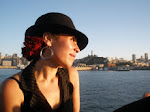
Papo Colo spent a year jumping fences and photographing his transgressions. Galeria de la Raza and Exit Art (of NYC) bring his lyrical and photography exhibition, Jumping the Fences, to San Francisco.
In jumping fences, Colo brings out the dualities of borders and fences. Fences are ubiquitous, whether in rural or urban locations, to the point that we hardly think on them. In Jumping the Fences, though, the nature of them becomes clear, that they keep out and keep in; protect and isolate; divide and unify. Jumping a fence is a transgression, one made all the more clear by Colo, who masks himself in each of his jumps. With his face hidden, he becomes anonymous, one of any number of people who don´t belong climbing over a fence, who, by doing so, undermines why the fence is there: the mark off property, to keep people out according to the discretion of the owner.
Even though each photo captures essentially the same image: a masked man climbing over a fence, the images are all drastically different in lighting, background, setting. They capture different phases of climbing and jumping, from hoisting himself up, hauling himself over, to jumping off, vaulting over, climbing up or descending. The foist is the same, each works to undermine the point of these fences, subverting their authority to say, ¨keep out.¨
In each image, from a myriad of locations around the world, the fence or wall is always angular, a rectangular form in contrast to which Colo´s body bends and morphs from one position to another. The malleable, movable body over the inertia of the walls revels in its empowerment in these photographs. There is not much the walls can do to stop anyone from climbing them.
This empowerment is exactly what Colo catches in the poetry paired with the images and action of jumping fences. It is not poetry that clamors to get over or despairs at being locked down on one side, but is full of possibility, and the discovery of freedom and potential in himself.
March 07:
To jump is to understand the impossible
maintaing myself in nothingness
the space that you break
is the air you pass through
in that instant you understand freedom
Colo´s project had him jumping fences around the world, passing through borders and always unlimiting himself by penetrating boundaries and his poetry reflects the potential imbued in movement and transgression: ¨me and my body jumping/inside any freedom possible¨(Feb 07). Colo surmounts staid impossibility with the possibility of movement.
Papo Colo, Jumping the Fences at Galeria de la Raza, 2857 24th St, San Francisco, Ca 94110 April 18, 2009 through May 31, 2009


